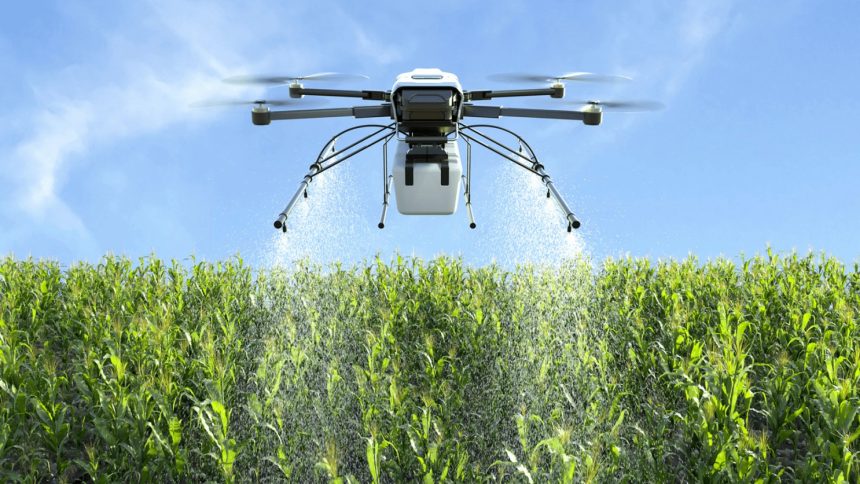For decades, farmers have searched for ways to grow more with fewer resources. Rising input costs, unpredictable weather, and shrinking labor availability make farming harder every season. Rural entrepreneurs also face the challenge of finding technology that can deliver both profit and sustainability.
Agri drones are now providing a practical answer to these issues. These flying machines, equipped with advanced spraying and monitoring tools, are changing the way crops are managed. Across the globe, farmers are using drones to cover more acres in less time, reduce waste, and protect the environment. By improving accuracy and reducing manual effort, drone technology is helping farms reach higher efficiency than ever before.
The Global Growth of the Agricultural Drones Market
The agricultural drone market is no longer a niche segment; it is a growing global force. Governments, agribusinesses, and tech innovators are recognizing their role in transforming farming.
With better hardware, smarter software, and accessible service models, agri drones are moving from being experimental tools to becoming an everyday part of modern farming.
Market Size and Growth Forecasts
Industry reports show that the global agricultural drones market was valued at over USD 4 billion in 2023. Experts predict it will grow at a compound annual growth rate (CAGR) of more than 20% from 2024 to 2030. Asia-Pacific countries, including India, are expected to account for a major share of this growth. This rapid expansion reflects both technological progress and rising awareness among farmers.
Drivers Behind Market Expansion
Several factors are pushing the agricultural drone market forward. Precision farming practices are helping farmers save costs while improving yields. Many governments offer subsidies or training programs for drone use in agriculture. Growing demand for sustainable methods is encouraging reduced chemical usage. Integration of artificial intelligence is improving the accuracy of data analysis.
Key Technologies Enhancing Agricultural Drone Capabilities
Technological improvements are making drones more effective, easier to use, and more valuable for farming. These advancements are turning drones into powerful field assistants that can gather data, spray crops, and assist in long-term farm planning.
Multispectral and Hyperspectral Imaging
These imaging technologies allow drones to capture detailed crop health information beyond what the human eye can see. Farmers can detect nutrient deficiencies, pest infestations, or disease at early stages. Early detection means faster intervention and lower losses, ensuring healthier crops and better harvests.
AI and Machine Learning Integration
Artificial intelligence helps process the vast amount of data drones collect. Machine learning algorithms can identify patterns, predict pest outbreaks, or recommend irrigation schedules. This turns raw drone footage into actionable insights, making decision-making faster and more accurate.
Drone-as-a-Service (DaaS) Models
Buying a drone may not be practical for every farmer. DaaS allows farmers to book drone spraying or monitoring services through an app or local operator. This model lowers the entry barrier, especially for small- and medium-scale farmers who want the benefits of drone technology without the ownership cost.
Practical Applications for Maximizing Farm Efficiency
Drones go beyond technology; they deliver real results by saving time, cutting waste, and boosting productivity. Here’s how they help farmers and rural entrepreneurs.
Precision Spraying and Resource Savings
Drones spray with high accuracy, using less water, pesticides, and fertilizers, saving costs and reducing environmental impact.
Crop and Soil Monitoring
Frequent drone flights give real-time crop and soil data, helping farmers act quickly to improve yields.
Mapping and Yield Prediction
Drone maps highlight field issues and crop density, enabling accurate yield forecasts and better harvest planning.
Regional Trends and Adoption Patterns Worldwide
Global adoption of agricultural drones is advancing at different speeds, influenced by local needs and policies. Key trends include:
- North America and Europe: Early adopters with strong regulations and advanced research support.
- Asia-Pacific: Rapid growth in China, Japan, and India, backed by large farms and government subsidies.
- India: Subsidized drone spraying is helping farmers adopt the technology faster.
- Emerging Markets: Latin America and Africa use drones to boost small farm yields and promote sustainable agriculture.
Challenges and Future Opportunities in Agricultural Drones
While the potential of drones is immense, some barriers remain. Addressing these will shape how quickly farmers everywhere can benefit from the technology.
At the same time, ongoing innovations promise even more powerful tools in the years ahead.
- Strict regulations on drone flights, especially for beyond-visual-line-of-sight operations, can limit their use. Import tariffs and hardware availability can also affect pricing and accessibility.
- Farmers and operators need proper training to use drones effectively. Certification programs and awareness campaigns are crucial to ensure safety and maximize benefits.
- Future trends include automated drone fleets that can work around the clock, advanced AI tools for real-time analysis, and integration with weather data for even smarter decision-making.
Conclusion
Agricultural drones are no longer experimental—they are proven tools for improving efficiency, productivity, and sustainability. From precision spraying to AI-powered crop monitoring, drones are reshaping how farms operate worldwide. For Indian farmers and rural entrepreneurs, this technology is not just a glimpse of the future; it is an opportunity available today, ready to deliver lasting results.





